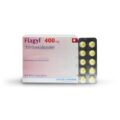What is amoxicillin?
Amoxicillin is a penicillin antibiotic that fights bacteria. Amoxicillin is used to treat many different types of infection caused by bacteria, such as tonsillitis, bronchitis, pneumonia, and infections of the ear, nose, throat, skin, or urinary tract. Amoxicillin is also sometimes used together with another antibiotic called clarithromycin (Biaxin) to treat stomach ulcers caused by Helicobacter pylori infection. This combination is sometimes used with a stomach acid reducer called lansoprazole (Prevacid).
According to New York Times, the number of older Americans coming to Mexico for discount medications has fueled an industry that thrives off the ability of consumers to pass through United States Customs with little or no hassle, and has raised safety concerns on both sides of the border.
In Nuevo Laredo, Tijuana, Los Algodones and other communities, the number of pharmacies has doubled, sometimes tripled, in recent years. Tijuana has 1,500 pharmacies, up from 500 four years ago, according to the city’s association of pharmacies. Many of these have sprung up in a couple of days, medications filling the shelves before walls are completed. Mexican laws allow stores to open with just a business license and allow pharmacists to work with no training in dispensing drug prescriptions.
What does Genuine Mexican Amoxicillin look like?
Genuine Mexican Amoxicillin Brands like in other parts of the world contain the active ingredient Amoxicillin trihydrate. The other ingredients are Magnesium Stearate (E572) and Colloidal Anhydrous Silica. Amoxicillin 250mg and 500mg capsule shells contain Gelatin, Carmoisine (E122), Quinoline Yellow (E104), Titanium Dioxide (E171), and Iron Oxide Yellow (E172). The brands include Gilmalxina, aAmoxil, Amoxicilina, and Vizimox.
Important Information
Do not use this medication if you are allergic to amoxicillin or to any other penicillin antibiotic, such as ampicillin (Omnipen, Principen), dicloxacillin (Dycill, Dynapen), oxacillin (Bactocill), penicillin (Beepen-VK, Ledercillin VK, Pen-V, Pen-Vee K, Pfizerpen, V-Cillin K, Veetids), and others.
Before using amoxicillin, tell your doctor if you are allergic to cephalosporins such as Omnicef, Cefzil, Ceftin, Keflex, and others. Also tell your doctor if you have asthma, liver or kidney disease, a bleeding or blood clotting disorder, mononucleosis (also called “mono”), or any type of allergy.
Amoxicillin can make birth control pills less effective. Ask your doctor about using a non-hormone method of birth control (such as a condom, diaphragm, spermicide) to prevent pregnancy while taking this medicine. Take this medication for the full prescribed length of time. Your symptoms may improve before the infection is completely cleared. Amoxicillin will not treat a viral infection such as the common cold or flu. Do not share this medication with another person, even if they have the same symptoms you have.
Antibiotic medicines can cause diarrhea. This may happen while you are taking amoxicillin, or within a few months after you stop taking it. This may be a sign of a new infection. If you have diarrhea that is watery or bloody, stop taking this medicine and call your doctor. Do not use anti-diarrhea medicine unless your doctor tells you to.
Before taking this medicine
You should not use amoxicillin if you are allergic to any penicillin antibiotic, such as ampicillin, dicloxacillin, oxacillin, penicillin, or ticarcillin.
To make sure this medicine is safe for you, tell your doctor if you have:
- kidney disease;
- mononucleosis (also called “mono”);
- diarrhea caused by taking antibiotics; or
- food or drug allergies (especially to a cephalosporin antibiotic such as Omnicef, Cefzil, Ceftin, Keflex, and others).
It is not known whether this medicine will harm an unborn baby. Tell your doctor if you are pregnant or plan to become pregnant.
Amoxicillin can make birth control pills less effective. Ask your doctor about using a non-hormonal birth control (condom, diaphragm, cervical cap, or contraceptive sponge) to prevent pregnancy.
It may not be safe to breastfeed while using this medicine. Ask your doctor about any risk.
How should I take Mexican amoxicillin?
Take amoxicillin exactly as prescribed by your doctor. Follow all directions on your prescription label and read all medication guides or instruction sheets. Take amoxicillin at the same time each day. Some forms of amoxicillin may be taken with or without food. Check your medicine label to see if you should take your mediicne with food or not.
Shake the oral suspension (liquid) before you measure a dose. Measure liquid medicine with the dosing syringe provided, or use a medicine dose-measuring device (not a kitchen spoon). You may mix the liquid with water, milk, baby formula, fruit juice, or ginger ale. Drink all of the mixture right away. Do not save for later use.
If you are taking amoxicillin with clarithromycin and/or lansoprazole to treat stomach ulcer, use all of your medications as directed. Read the medication guide or patient instructions provided with each medication. Do not change your doses or medication schedule without your doctor’s advice.
Use this medicine for the full prescribed length of time, even if your symptoms quickly improve. Skipping doses can increase your risk of infection that is resistant to medication. Amoxicillin will not treat a viral infection such as the flu or a common cold.
Do not share this medicine with another person, even if they have the same symptoms you have.
This medicine can affect the results of certain medical tests. Tell any doctor who treats you that you are using this medicine .
Store at room temperature away from moisture, heat, and light.
You may store liquid Mexican amoxicillin in a refrigerator but do not allow it to freeze. Throw away any liquid medicne that is not used within 14 days after it was mixed at the pharmacy.
What happens if I miss a dose?
Skip the missed dose and use your next dose at the regular time. Do not use two doses at one time.
What happens if I overdose?
Seek emergency medical attention or call the Poison Help line at 1-800-222-1222.
What should I avoid while taking Mexican amoxicillin?
Antibiotic medicines can cause diarrhea, which may be a sign of a new infection. If you have diarrhea that is watery or bloody, call your doctor before using anti-diarrhea medicine.
Mexican Amoxicillin side effects
Get emergency medical help if you have signs of an allergic reaction to amoxicillin (hives, difficult breathing, swelling in your face or throat) or a severe skin reaction (fever, sore throat, burning eyes, skin pain, red or purple skin rash with blistering and peeling).
Call your doctor at once if you have:
- severe stomach pain; or
- diarrhea that is watery or bloody (even if it occurs months after your last dose).
- Common amoxicillin side effects may include:
- nausea, vomiting, diarrhea;
This is not a complete list of side effects and others may occur. Call your doctor for medical advice about side effects.
READ: Ampitrexyl vs Penicillin: Differences, Similarities, Which is Better?





